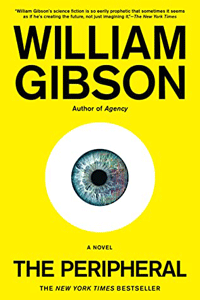After enjoying Season 1 of Amazon Prime’s “The Peripheral” enough to come back for Season 2, I decided to fill the offseason with a read of William Gibson’s 2014 novel on which the show is based. Perhaps shamefully, I hadn’t previously tried a Gibson book, although I knew him as the father of cyberpunk, and I knew he wrote two solid “X-Files” episodes.
Gibson’s novel makes me appreciate the show more, and the show makes me appreciate the book more. If “The Peripheral” is representative of his work, though, he’s quite idiosyncratic for a popular sci-fi writer.
He writes short little chapters, each building up the reality and the rules a bit more – but leisurely, almost lazily. His writing initially feels clunky, with subject nouns sometimes being left out of sentences, but I got into the rhythm. Eventually it’s a whole book, but without as much plot or characters as most books.
The plot isn’t the point
“The Peripheral” barely has a plot. Flynne (Chloe Grace Moretz in the show) goes 70 years into the future via a crown that’s so much like a VR device that she assumes she’s in a game, operating a drone in London. She witnesses a murder on a high balcony of a building. Because of vague political machinations that Gibson himself likely didn’t figure out, Flynne then gets targeted by bad guys in her own time, hired via the future.

“The Peripheral” (2014)
Author: William Gibson
Genre: Science fiction
Settings: Near-future North Carolina, and 70 years later in London
The characters – although they do have personalities and warmth (and although there are dozens of them) — don’t develop much. These are generally flaws, but here we must ask: Would the book be better if it emphasized plots and character arcs? In this case, likely not.
“The Peripheral” builds a world and all its rules, similar to a tabletop RPG guide; it lacks a complex plot and character arcs because Gibson was never interested in coming up with any. Scott Smith, the TV series’ runner and himself an author, took Gibson’s world and added the stuff of narrative TV. But he owes a lot to Gibson’s foundational vision.
Gibson is great at dreaming up something wild but grounding it in plausibility. Flynne, her brother Burton (Jack Reynor on the show) and Burton’s military bud Conner (Eli Goree on the show) jump from near-future North Carolina to distant-future London by having their minds transfer into peripherals. These are like golems that they self-animate.
While this might not sound plausible, Gibson reverse-engineers it to become plausible by spending a lot of time on how Flynne and company feel about transferring into a different body. Initially, nausea results, for instance.
Controlled by the future
In North Carolina, Flynne and family and friends keep logistically busy by becoming the controlling owners of Milagros Coldiron (Cyberdyne with more diversification, to use a “Terminator” parallel) and setting up bases of operations and safety. Yet they are essentially passive actors, receiving instructions.

The future is controlling them, specifically London police investigator Lowbeer (Alexandra Billings on the show), although even she doesn’t have the full picture. Indeed, the future creates Flynne’s very timeline (a “stub”) by the act of communicating through time. This stub then branches off from the timeline that became the future Lowbeer knows.
The passivity of character is nowhere more evident than in Wilf (Gary Carr on the show), our 70-years-later POV character, who alternates chapters with Flynne. As in the show, Wilf hangs out at powerful Zubov’s mansion, employed in an unclear position — but he’s present for most of the action, basically so we have a reader surrogate.
In one of those classically weird across-time romances, Wilf is attracted to Flynne – but how does that play in regard to her peripheral, an artificial creation? And to the fact that she’s either dead or an undocumented elderly woman in his own time?
Smith generally improves on Gibson’s work, but there’s one exception. The book heavily features Ash (Katie Leung) – who has moving tattoos — but she’s unfortunately (given that Leung is an intriguing presence) more backgrounded in the show. Here’s an example of the novel helping the TV series, though: I now understand that Ash’s and Ossian’s special language is gibberish temporary code. Now I’m even more impressed by the actors’ dialog scenes in this manner.
What’s wrong with this future?
In addition to crafting the rules of this world, Gibson imagines tech, including a gun that vaporizes people. (The TV show goes with a gun that delivers a massive invisible punch, lethal or nearly so.)
The author also gets extremely weird at times, including a chapter where Wilf and Lowbeer transfer their essences into animals (and not even real ones, but artificially created breeds) in order to talk privately in this post-privacy world.
As other SF writers have anticipated, we’ll eventually essentially merge with our cellphones. In “The Peripheral,” an icon pops up in a person’s field of vision, meaning they are receiving a communication. A click of their tongue on their palette and they’re speaking to the person. Every communication is instantly recorded as metadata, the instant analysis of which Lowbeer always has available – an extrapolation from today.
For all the convenient tech, Wilf doesn’t like his reality. It seems wrong to him. Interestingly – and perhaps this is a flaw, perhaps not – Gibson doesn’t dig into why the future feels wrong to Wilf and others. But this allows us to extrapolate. Perhaps the lack of privacy leads to a lack of individuality.
Gibson’s “The Peripheral” resolves its plot, such as it is, but it remains more of a sketch than a complete work (despite being nearly 500 pages long, with more than 100 chapters, and taking me weeks to read). Luckily, we have the TV show as an outlet for further exploration of where Flynne’s world (and perhaps our own) is headed.

